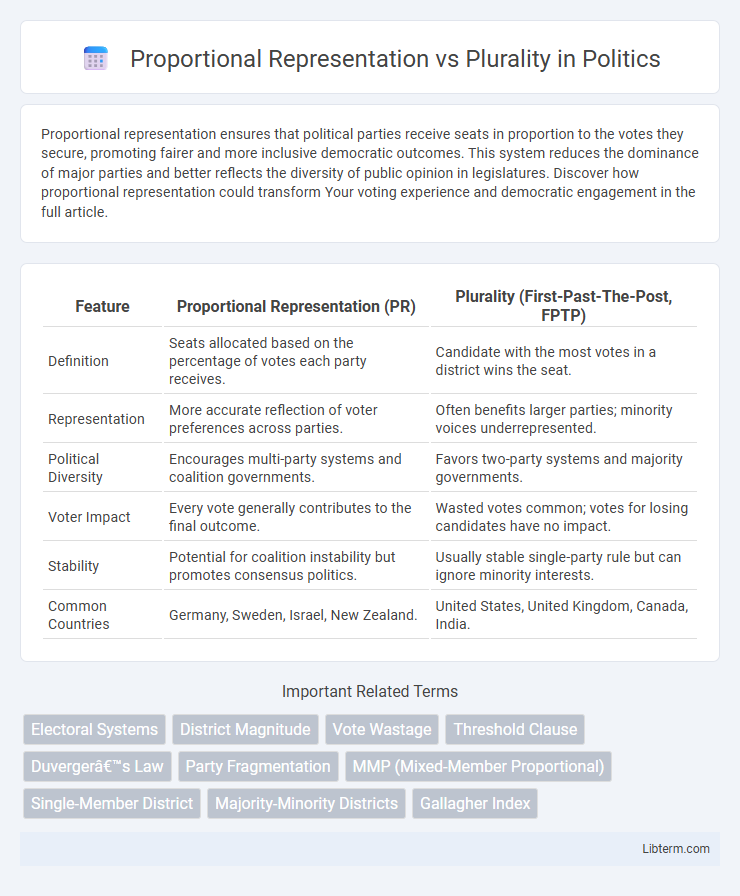Proportional representation ensures that political parties receive seats in proportion to the votes they secure, promoting fairer and more inclusive democratic outcomes. This system reduces the dominance of major parties and better reflects the diversity of public opinion in legislatures. Discover how proportional representation could transform Your voting experience and democratic engagement in the full article.
Table of Comparison
| Feature | Proportional Representation (PR) | Plurality (First-Past-The-Post, FPTP) |
|---|---|---|
| Definition | Seats allocated based on the percentage of votes each party receives. | Candidate with the most votes in a district wins the seat. |
| Representation | More accurate reflection of voter preferences across parties. | Often benefits larger parties; minority voices underrepresented. |
| Political Diversity | Encourages multi-party systems and coalition governments. | Favors two-party systems and majority governments. |
| Voter Impact | Every vote generally contributes to the final outcome. | Wasted votes common; votes for losing candidates have no impact. |
| Stability | Potential for coalition instability but promotes consensus politics. | Usually stable single-party rule but can ignore minority interests. |
| Common Countries | Germany, Sweden, Israel, New Zealand. | United States, United Kingdom, Canada, India. |
Introduction to Electoral Systems
Proportional representation allocates seats based on the percentage of votes each party receives, ensuring diverse political views are fairly represented in the legislature. Plurality systems, or "first-past-the-post," award seats to candidates who receive the most votes in single-member districts, often benefiting larger parties and leading to majority governments. These fundamental differences shape the political landscape by influencing party systems, voter behavior, and the overall inclusiveness of electoral outcomes.
Defining Proportional Representation
Proportional representation (PR) is an electoral system designed to allocate seats in a legislature in proportion to the number of votes each party receives, ensuring broader and more accurate representation of voter preferences. Unlike plurality systems, where the candidate with the most votes wins and can result in disproportional outcomes, PR aims to minimize wasted votes and reflect the political spectrum more equitably. By promoting multi-party participation and coalition governance, proportional representation strengthens democratic inclusivity and reduces the dominance of major parties.
Understanding Plurality Voting Systems
Plurality voting systems award victory to the candidate with the most votes, even if they lack an absolute majority, often leading to a "winner-takes-all" outcome that can marginalize smaller parties. This system is prevalent in countries like the United States and the United Kingdom, where single-member districts dominate electoral processes. Understanding plurality helps explain why these systems tend to produce two-party dominance and can impact voter representation diversity compared to proportional representation models.
Historical Context of Both Systems
Proportional representation (PR) emerged in the early 20th century as a response to the limitations of plurality voting, aiming to better reflect diverse political preferences within legislatures. Plurality systems, also known as first-past-the-post, have roots in British electoral practices dating back centuries, emphasizing direct candidate victory in single-member districts. Historical adoption of PR in countries like Germany and the Netherlands contrasted with the longstanding use of plurality in the United Kingdom and the United States, highlighting divergent approaches to democratic representation and political stability.
Key Advantages of Proportional Representation
Proportional Representation (PR) ensures that political parties receive seats corresponding closely to their share of the vote, enhancing electoral fairness and inclusivity. This system promotes diverse representation, allowing minority groups and smaller parties to have a voice in legislatures, which is often limited under Plurality voting. PR reduces wasted votes and encourages higher voter turnout by making each vote more impactful in the election outcome.
Strengths of Plurality Systems
Plurality systems offer simplicity and clarity by awarding victory to the candidate with the most votes, facilitating swift and decisive election outcomes. This system tends to produce stable governments by often enabling a single party to secure a clear majority, reducing the likelihood of coalition complexities. Voter accountability is heightened as representatives are directly linked to specific geographic constituencies, fostering closer connections between elected officials and their communities.
Criticisms and Drawbacks of Each Approach
Proportional Representation often faces criticism for enabling fragmented legislatures and empowering small parties that can exert disproportionate influence on coalition governments, potentially leading to instability and decision-making gridlock. Plurality systems are criticized for disproportional outcomes where major parties dominate, often marginalizing minority voices and leading to a phenomenon known as "wasted votes," which can distort true voter preferences. Both approaches struggle with balancing fair representation and effective governance, highlighting ongoing debates in electoral system design.
Impact on Political Parties and Representation
Proportional representation systems enable smaller and diverse political parties to gain seats aligned with their actual vote share, promoting multi-party representation and coalition governance. Plurality systems often favor larger parties, leading to a two-party dominance that can marginalize minority views and reduce political diversity. This disparity influences legislative inclusivity, policy debates, and voter representation, shaping overall democratic responsiveness.
Case Studies: Countries and Their Electoral Systems
The United Kingdom utilizes a Plurality voting system, specifically First-Past-The-Post, often resulting in single-party majority governments but criticized for underrepresenting smaller parties. In contrast, Germany employs a Mixed-Member Proportional system that ensures both local representation and proportional allocation of seats, promoting coalition governments and broader political inclusion. New Zealand adopted a Mixed-Member Proportional system in 1996 after dissatisfaction with Plurality outcomes, leading to more accurate representation of voter preferences and enhancing the presence of minor parties in Parliament.
Future Trends and Reform Debates
Future trends in electoral systems indicate increasing interest in proportional representation (PR) due to demands for fairer voter representation and greater political diversity, with countries like New Zealand and Scotland exemplifying successful PR adoption. Reform debates center on challenges of plurality systems, such as the winner-takes-all effect and underrepresentation of minority voices, prompting advocates to push for mixed-member proportional models or ranked-choice voting as transitional solutions. Technological advancements and growing public awareness are driving momentum toward hybrid electoral frameworks aimed at enhancing transparency and inclusivity in democratic processes.
Proportional Representation Infographic

 libterm.com
libterm.com